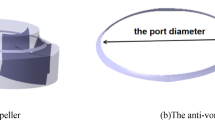Abstract
The high aerodynamic noise induced by automotive air conditioning systems has important effects on the ride comfort, and the centrifugal fan is the largest noise source in these systems. It is very important to reduce the aerodynamic noise generated by the centrifugal fan. The flow field and the sound field on the whole centrifugal fan configuration have been carried out using the computational fluid dynamics. Simulation results show that the sound pressure level near the outlet of the centrifugal fan is too high. Based on the relationship between flow characteristics and the aerodynamic noise, four parameters of the centrifugal fan, i.e., impeller blade’s outlet angle θ, volute tongue’s gap t, collector inclination angle β, and rotating speed n, were selected as design variables and optimized using response surface methodology. While keeping the function of flow rate unchanged, the peak noise level is reduced by 8 dB or 10.8%. The noise level is satisfactorily reduced.
Similar content being viewed by others
References
CHEN Xiao-ping. Sound and hearing perception [M]. Beijing: China Radio & Television Publishing House, 2006: 18–22. (in Chinese)
BALLESTEROS-TAJADURA R, VELARDE-SUÁREZ S, HURTADO-CR-UZ J P. Noise prediction of a centrifugal fan: Numerical results and experimental validation [J]. ASME J Fluids Eng, 2008, 130: 091102.
CHO Y, MOON Y J. Discrete noise prediction of variable pitch cross-flow fans by unsteady Navier-stokes computations [J]. ASME J Fluids Eng, 2003, 125: 543–550.
FFOWCS WILLIAMS J E, HAWKINGS D L. Sound generation by turbulence and surfaces in arbitrary motion [J]. Proceedings of the Royal Society of London A, 1969, 264: 321–342.
BALLESTEROS-TAJADURA R, VELARDE-SUÁREZ S, HURTADO-CRUZ J P, SANTLARIA-MORROS C. Numerical calculation of pressure fluctuations in the volute of a centrifugal fan [J]. ASME J Fluids Eng, 2006, 128: 359–369.
VELARDE-SUÁREZ S, BALLESTEROS-TAJADURA R, SANTOLARIA-MORROS C, PEREIRAS-GARĆA B. Reduction of the aerodynamic tonal noise of a forward-curved centrifugal fan by modification of the volute tongue geometry [J]. Applied Acoustics, 2008, 69: 225–232
QI Da-tong, MAO Yi-jun, LIU Xiao-liang, YUAN Min-jian. Experimental study on the noise reduction of an industrial forward-curved blades centrifugal fan [J]. Applied Acoustics, 2009, 70: 1041–1050.
LIU Guo-dan, WANG Gang, CAO Zhi-kun, HU Song-tao. Optimization of low noise for multi-blade centrifugal fan[J]. Noise & Vibration Control, 2007 (2): 125–127. (in Chinese)
MYERS R H, MONTGOMERY D C, ANDERSON-COOK C M. Response surface methodology: Process and product optimization using designed experiments [M]. Hoboken, USA: John Wiley & Sons Ltd, 2009: 73–135.
HUANG Zun-di, LIANG Xi-feng, ZHONG Mu. Optimization of wind-break wall based on Kriging model [J]. Journal of Central South University: Science and Technology, 2011, 42(7): 2152–2155. (in Chinese)
SENGUPTA T K, SIRCAR S K, DIPANKAR A. High accuracy schemes for DNS and acoustics [J]. Journal of Scientific Computing, 2006, 26(2): 151–193.
MOHAMUD O, JOHNSON P. Broadband noise source models as aeroacousitc tools in designing low NVH HVAC ducts [C]// SAE Technical paper. Detroit: SAE, 2006, 2006-01-1192.
LIGHTHILL M J. On sound generated aerodynamically: Part I-general theory [J]. Proceedings of the Royal Society of London A, 1952, 211: 564–587.
CURLE N. The influence of solid boundaries upon aerodynamic sound [J]. Proceedings of the Royal Society of London A, 1955, 231: 505–514.
Fluent Inc. Fluent 6.3 Users guide [R]. Fluent Inc, 2006.
YAN Jian-rong, GU Zheng-qi, LI Wei-ping, WANG Bei, PENG Ya-mei. The analysis and optimization on aeroacoustic characteristics of Multi-Forward-Curved-Blade centrifugal fan of automobile [J]. Automotive Engineering, 2009(6): 40–46. (in Chinese)
CHENG Xin-de. Centrifugal fan [M]. Beijing: Chemical Industry Press, 2007: 103–127. (in Chinese)
XIAO You-gang, KANG Zhi-cheng. Numerical prediction of aerodynamic noise radiated from high speed train head surface [J]. Journal of Central South University: Science and Technology, 2008, 36(6): 67–72. (in Chinese)
Author information
Authors and Affiliations
Corresponding author
Additional information
Foundation item: Project(50975083) supported by the National Natural Science Foundation of China; Project(61075001) supported by China State Key Laboratory of Advanced Design and Manufacturing for Vehicle Body; Project(2012-IV-068) supported by the Fundamental Research Funds for the Central Universities, China
Rights and permissions
About this article
Cite this article
Yang, Zd., Gu, Zq., Wang, Yp. et al. Prediction and optimization of aerodynamic noise in an automotive air conditioning centrifugal fan. J. Cent. South Univ. 20, 1245–1253 (2013). https://doi.org/10.1007/s11771-013-1608-6
Received:
Accepted:
Published:
Issue Date:
DOI: https://doi.org/10.1007/s11771-013-1608-6




